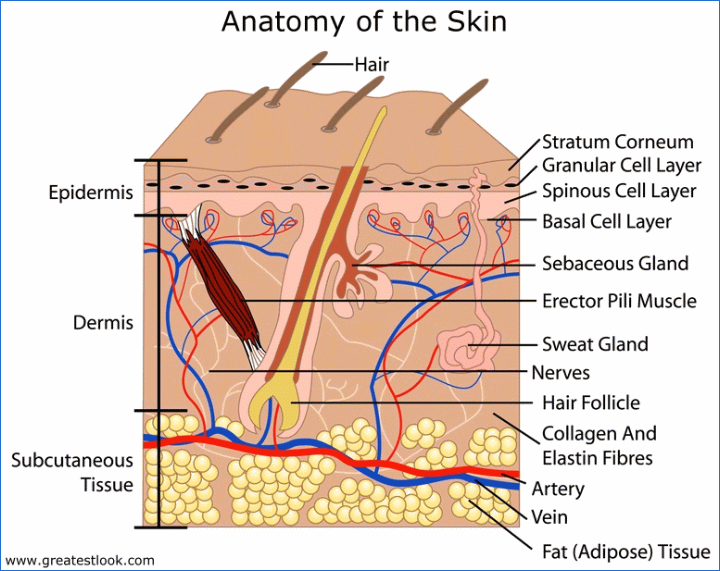Anatomy of the Skin

The skin is the largest organ of the human body, is the part of the body that most readily shows signs of aging, and is one of the first things people notice about you. Your skin is one of the most important parts of your body, and for most people is the part of the body that receives the harshest treatment.
The skin is the first line of defense of the immune system. It forms a protective barrier to germs and bacteria, toxins and other irritants, serves to regulate the body's temperature and expels bodily waste. It also has its own appendages: hair, nails, sweat glands and oil glands. Normal healthy skin is slightly moist, soft and flexible, with a texture that is ideally smooth and fine-grained. Healthy skin also has a slightly acidic pH.
Skin is thickest on the palms of the hands and soles of the feet, and thinnest on the eyelids. Constant pressure on any part of the skin can stimulate keratin formation and cause thickening of the area into a callus. It is made up of two layers - the epidermal and dermal layers.
The epidermal layer is the thinnest of the layers and is made up of its own set of thinner layers. The outermost layer is composed of keratin (a fiber protein) cells. These cells combine with a thin layer of oil to create a water-proof layer. Beneath this is a clear transparent layer through which light can pass. Next is a layer of granular cells that are almost deal and are pushed to the surface to replace the cells of keratin that are shed constantly.
Finally is the base layer of the epidermis which contains several layers of different shaped cells. This layer is responsible for the growth of the epidermis, and contains dark skin pigment called melanin. Melanin protects the layers below the epidermis from the harmful effects of the ultraviolet rays of the sun and determines the skin's color.
The dermal layer is the connective layer of the skin and is about 25 times thicker than the epidermis. In the dermal layer you will find the blood vessels, lymph vessels, nerves, sweat glands, oil glands, hair follicles, and the small muscles that move the hairs of the skin. The dermal layer is also composed of sub-layers. The outermost of these layers, directly below the epidermis contains the nerve endings that are sensitive to touch and pressure, and also contains some melanin. The bottommost layer of the dermis supplies the skin with oxygen and nutrients. Here you will find fat cells, blood vessels, lymph vessels, oil glands, sweat glands, and hair follicles.
Skin Strength and Flexibility:
The strength and flexibility of your skin comes from two structures found in the dermal layer of the skin - collagen and elastin. Together, collagen and elastin make up about 70% of the dermal layer.
Collagen is a fibrous protein that gives the skin form and strength. It holds together all the various structures of the skin and gives it plumpness and firmness. Healthy collagen fibers allow the skin to stretch and contract, and when they become weakened due to lack of moisture in the skin, environmental damage, or frequent weight fluctuation, skin loses its tone and suppleness. This is what causes wrinkles and sagging.
Elastin is a protein base interwoven with the collagen fibers to form elastic tissue. This gives the skin its flexibility and elasticity. Elastin helps the skin resume its shape after expanding or stretching.
Both collagen and elastin fibers weaken as we age, so using moisturizers, eating healthy diets and exercising will help to slow this process.
©greatestlook.com